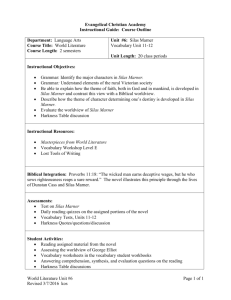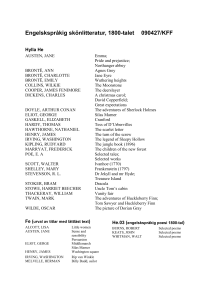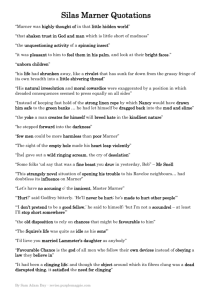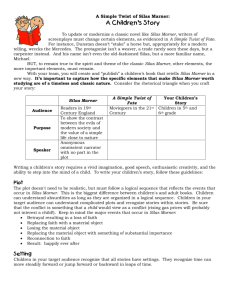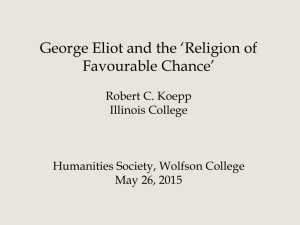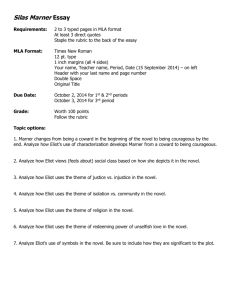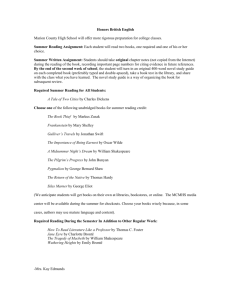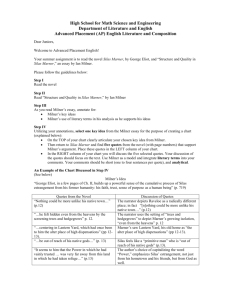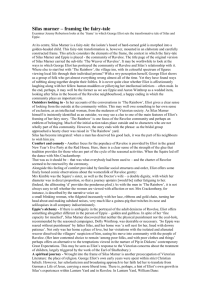SILAS MARNER'S LOSING AND REGAINING FAITH IN GEORGE
advertisement
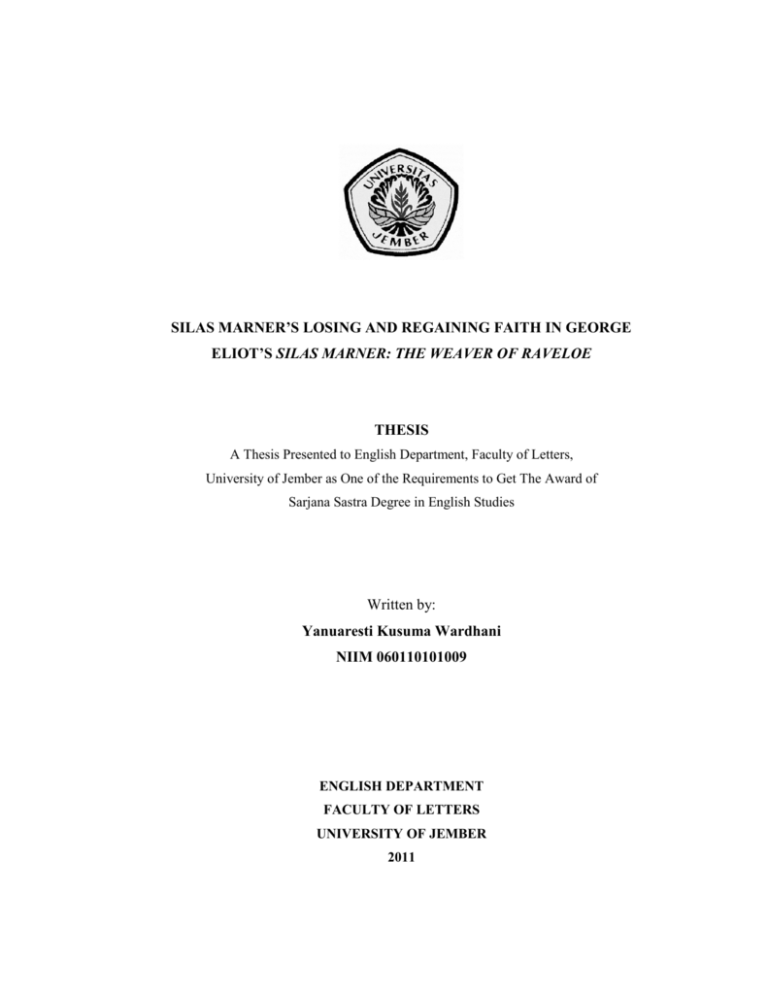
SILAS MARNER’S LOSING AND REGAINING FAITH IN GEORGE ELIOT’S SILAS MARNER: THE WEAVER OF RAVELOE THESIS A Thesis Presented to English Department, Faculty of Letters, University of Jember as One of the Requirements to Get The Award of Sarjana Sastra Degree in English Studies Written by: Yanuaresti Kusuma Wardhani NIIM 060110101009 ENGLISH DEPARTMENT FACULTY OF LETTERS UNIVERSITY OF JEMBER 2011 DEDICATION PAGE My Great Allah SWT, who gives me the ability to present this thesis. Nothing I can do without You. My super mommy, Dra. Retno Winarni, M. Hum. and my enormous daddy, Drs. Haryanto. Thank you for giving me your great and wonderful love. You are the best parents. My two beloved little brothers, Willy Kriswardhana and Gama Yoga Prasetya. I cannot stop loving you boys! My Alma mater. ii MOTTO “I believe God is managing affairs and that He doesn’t need any advice from me. With God in charge, I believe everything will work out for the best in the end. So what is there to worry about.” Henry Ford iii DECLARATION I hereby state that the thesis entitled ―Silas Marner‘s Losing and Regaining Faith in George Eliot‘s Silas Marner: The Weaver of Raveloe‖ is an original piece of writing. I certify that the analysis and the result described in this thesis have not already been submitted for any other degree or any publications in this institution. I certify to the best of my knowledge, that all sources used and any help received in the preparation of this thesis have been acknowledged. Jember, May 04th 2011 The Writer Yanuaresti Kusuma Wardhani 060110101009 iv APPROVAL SHEET Approved and received by the Examination Committee of English Department, Faculty of Letters, University of Jember. Jember, May 09th 2011 Chairman, Secretary, (……………………..) (….………………...) Prof. Dr. Samudji, M.A. Dewianti Khazanah, S.S. NIP. 194808161976031002 NIP. 198511032008122002 The Members: (……………………) 1. Dra. Hj. Meilia Adiana M.Pd. NIP. 195105211981032002 (……………………) 2. Drs. Imam Basuki, M. Hum. NIP. 196309041989021001 (……………………) 3. Erna Cahyawati, S.S., M.Hum. NIP. 197308271999032004 Approved by the Dean, Drs. Syamsul Anam, M.A. NIP. 195909181988021001 v ACKNOWLEDGMENT Profoundly I am very grateful to My Great Allah SWT for giving me the chance to finish composing this thesis through my weakness and limitedness. A bunch of thanks I sent to You. The other gratitude I ultimately extend to those who have been kind to assist me and give their contributions to complete this thesis. They are: 1. Drs. Syamsul Anam, M.A., the Dean of Faculty of Letters and Drs. Moch. Ilham, M. Si., the Head of English Department who have permitted me to begin writing this thesis. 2. Dra. Hj. Meilia Adiana, M.Pd., as my first advisor, and Drs. Imam Basuki, M. Hum, as my second advisor. My deep gratitude to whom I extend for their valuable suggestions, advice, patience and guidance. 3. All the lecturers of the English Department, Faculty of Letters. Without their useful subjects and knowledges given to me, I would never be able to write this thesis. 4. All of the staffs at Faculty of Letters. Thanks for helping me in anything refers to administration. 5. All the librarians both Jember University and Faculty of Letters, for giving the best services to help me complete this thesis. 6. My torchbearer, Yulia ―Yoelikman‖ Astriyanto. Thanks for making me cheerful. Hopefully you will be Sarjana Sastra as soon as posibble. Be my wonderful man forever! 7. My best friends, Alyssa Eva and Qurrotul Faizah. I will never forget our togetherness since the first semester to present. 8. All my friends in English Department of 2006 that I cannot mention one by one. Thank you for sharing in the same struggle with me. vi 9. All of the crews and friends at Faculty of Letters parking area. Thanks for making me happy and colouring the days during my study in Faculty of Letters. 10. My two technicians, thanks for repairing my notebook and guiding me in learning IT. 11. Everyone, who has shared and supported my thesis, I am not able to mention in detail. Thank you very much. Jember, May 2011 Yanuaresti Kusuma W. vii TABLE OF CONTENTS TITLE PAGE ......................................................................................... i DEDICATION ........................................................................................ ii MOTTO .................................................................................................. iii DECLARATION .................................................................................... iv APPROVAL SHEET ............................................................................. v ACKNOWLEDGEMENTS ................................................................... vi SUMMARY ............................................................................................ vii TABLE OF CONTENTS ....................................................................... viii CHAPTER1. INTRODUCTION 1.1 Rationale ....................................................................... 1 1.2 The Problem to Discuss ................................................ 2 1.3 The Goals of the Study.................................................. 3 1.4 The Method of Research ............................................... 3 CHAPTER 2. THEORETICAL FRAMEWORK 2.1 The Previous Researches .............................................. 5 2.2 The Approach to Use .................................................... 8 2.4.1 The Theory of Losing Faith in Young People ...... 8 2.4.2 The Theory of Religious Conversion .................... 12 CHAPTER 3. SILAS MARNER’S LOSING AND REGAINING FAITH IN GEORGE ELIOT’S SILAS MARNER: THE WEAVER OF RAVELOE 3.1 Three Theological Virtues ............................................ 16 3.2 Silas Marner’s Background ......................................... 18 viii 3.2.1 Silas Marner‘s Former Faith ..................................... 18 3.2.2 Silas Marner‘s Former Place ..................................... 19 3.3 Church in England and Its Function........................... 20 3.4 The Causes of Silas Marner’s Losing Faith ................ 25 3.4.1 The Strict Belief System ........................................... 26 3.4.2 The Bitterness of His Life ......................................... 28 3.5 The Effects of Silas Marner’s Losing Faith ................ 29 3.5.1 Being an Individual Person ....................................... 30 3.5.2 Being a Money Oriented Person ............................... 32 3.6 The Causes of Silas Marner’s Regaining Faith .......... 34 3.6.1 The Second Theft ...................................................... 34 3.6.2 The Support from Neighbors .................................... 36 3.6.3 The Little Girl‘s Coming........................................... 38 3.7 The Effects of Silas Marner’s Regaining Faith .......... 40 3.7.1 Society‘s Acceptance ................................................ 40 3.7.2 Happy Life ................................................................ 41 CHAPTER 4. CONCLUSION .............................................................. 44 BIBLIOGRAPHY APPENDICES ix CHAPTER 1. INTRODUCTION 1.1 Rationale Literature has an important lesson for human life. By reading literary works, people may get information and experience although they do not experience as happens in the story of a literary work. People may learn how they undergo their life and become the better people after the process of reading. Cole and Lindemann state, ‖A writer may deliberately attempt to write literature by imaginatively creating an experience or an event and then communicating it through language in one of the recognized forms of poetry, prose, or drama.‖(1990:3) Novel is one of the literary forms that will be analyzed in this thesis. Silas Marner, a dramatic novel written by George Eliot. It is her third novel and has been published in 1861. The novel is set in the early years of 19th century. In this novel, Eliot implies about the life of English village. At that time, the village in England was influenced by the effects of Industrial Revolution. Based on the facts above, Silas Marner written by George Eliot is an interesting novel story. Long states that Silas Marner is artistically the most perfect of George Eliot‘s novel and we venture to analyze it as typical of her ideals and methods.(1909: 511). This novel not only tells about the great experience of a man, but also tells about the intrigue in high class families. By reading Silas Marner, the readers may know about the difference of social classes in 19th century England. Like all Eliot‘s novels, Silas Marner is depressing. Turning away from the happy ending, the story is started by the main character‘s sadness and incompleteness. It will give the readers moral value and message. The novel‘s main body of action takes place at the turn of the 19 th century in the English rural community. However, the story goes back briefly to the late of 18 th century to 1
